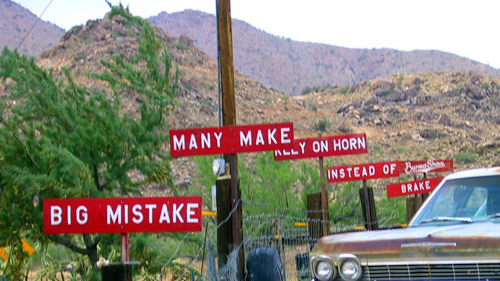
I don’t personally remember Burma-Shave signs; they were slightly before my time. But I’ve heard them mentioned from time to time and now I am researching all things Burmese for an upcoming lecture at school.
Burma-Shave signs were an advertising phenomenon, born as America’s highway system was growing. Rhyming sets of five painted boards with a kicker Burma-Shave logo on a sixth sign, they lined highways all over America through the 1930s, ’40s, and ’50s. The last of over 600 Burma-Shave jingles were posted in 1963.
Frank Rowsome Jr writes in his history of Burma-Shave signs, The Verse By the Side of the Road, “The signs themselves underwent continuous evolution. For the first five years they were one-inch pine boards, ten inches high and yard long, dip-painted twice with the background color mixed preservative. The lettering, a standard sign painter’s Gothic, was applied by silk screen. . . . To emphasize the new crop of jingles, signs alternated by years between red with white letterig and orange with black lettering. . . .
“Yearly alterations of color had seemed a good way to call attention to the new signs, but it was noticed that whenever people spoke of Burma-Shave signs, they invariably described them as red and white. Orange-and-black ones seem to have made no impression whatever on the public’s retina, or at least on its memory. At this the company gave up, going almost exclusively to red and white.”
Frank Rowsome Jr never mentions the original reason for the red and white color scheme, but a deep red is, unofficially, the national color of the country Burma (or Myanmar depending on which side of the political fence you’re on). But the red seemed right, to the designers of the original signs as well as the general public, which dismissed the orange signs as aberrations.
Burma-Shave
Leave a Reply
You must be logged in to post a comment.